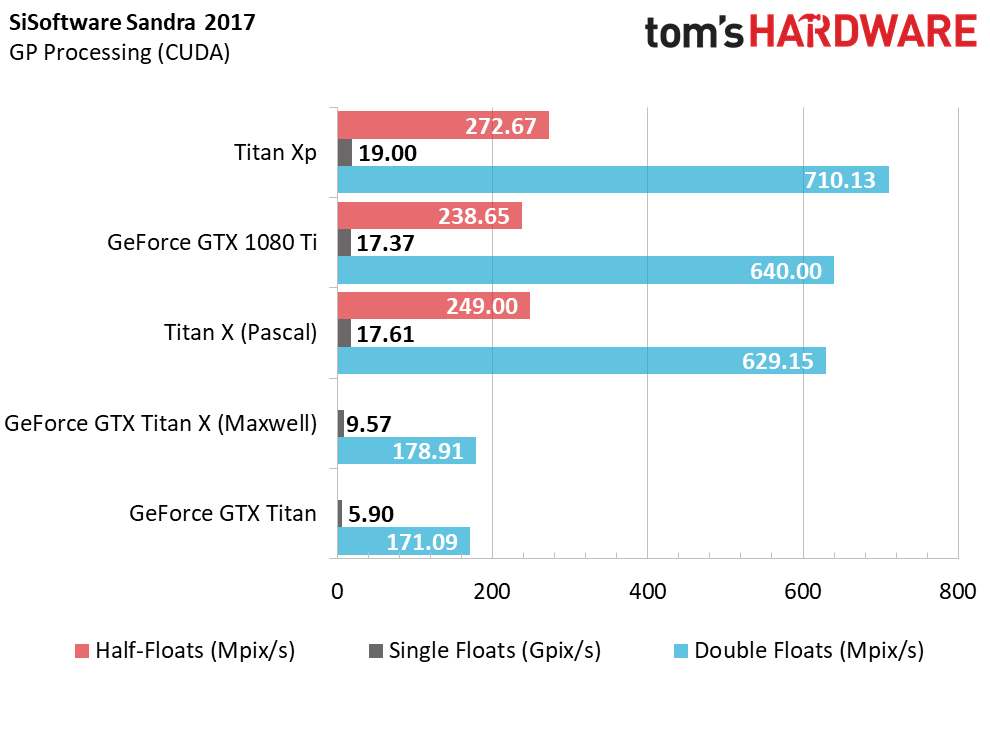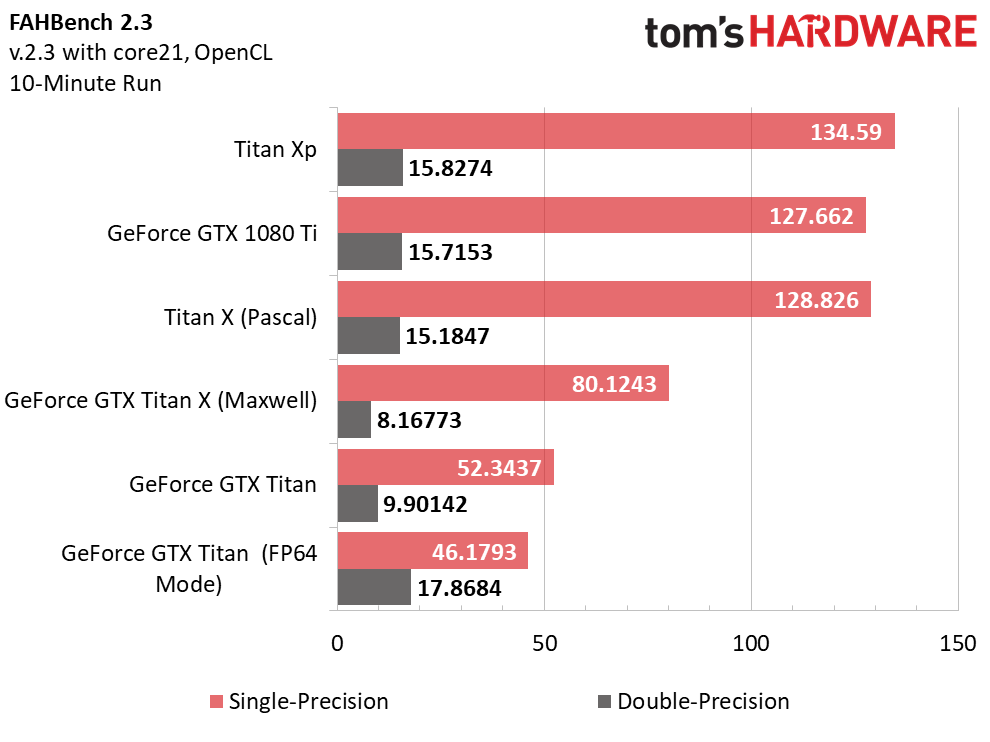Nvidia Titan Xp 12GB Review
Why you can trust Tom's Hardware
Compute
Once upon a time, the Titan name represented prosumer-level functionality. In addition to great gaming performance, Nvidia’s original Titan boasted theoretical FP64 processing power on par with the company’s Quadro and Tesla cards via GK110. That changed from Maxwell onward, where double-precision fell to 1/32 the rate of peak FP32 performance. Half-precision in the Pascal generation is even worse: you get a 1/64 rate of FP16 compared to FP32.
With each card configured as default, the difference between Titan Xp and the more hobbled GP102-based boards is evident. Those extra CUDA cores play the most prominent role in a compute workload, where they’re front and center. We measure an almost-8% improvement in single-floats and a >11% speed-up versus Titan X in double-floats using Sandra 2017.
The GeForce GTX Titan looks homely at the bottom of our chart. But if you jump into Nvidia’s driver control panel and enable "GeForce GTX Titan" under the Double precision drop-down menu, GPU Boost gets disabled and the FP64 cores operate at 8x their original frequency. Single-float performance takes a big hit, dropping to 2.66 Gpix/s. However, doubles jump from 171.09 Mpix/s to 2 Gpix/s. That’s more than two times the FP64 performance of Titan Xp or GeForce GTX 1080 Ti!
Nvidia’s Maxwell and Kepler architectures don’t support mixed precision like Pascal does, so they’re forced to emulate half-floats at the same rate as FP32 mode. Meanwhile, the GP102-based boards post real-world half-float results around 40% of their double-float numbers.
A 10-minute test run gives FAHBench plenty of time to warm up each card with a sample molecular dynamics calculation. The difference between single- and double-precision compute performance isn’t as pronounced here as it is in Sandra. To that point, Titan Xp’s extra CUDA cores only translate to a 4%-higher score compared to Titan X in a single-precision run.
By far, the biggest revelation comes from Nvidia’s GeForce GTX Titan, which is again humbled at the bottom of our chart. Flipping on its driver-based FP64 switch knocks the single-precision score down to 46.1793, while double-precision jumps to 17.8684. For a second time, we see the four-year-old card outperform Nvidia’s fastest desktop-class board.
A 7% speed-up over Titan X in LuxMark’s OpenCL renderer lands somewhere between our numbers in Sandra and FAHBench. Previous-gen GPUs are significantly slower.
Get Tom's Hardware's best news and in-depth reviews, straight to your inbox.
MORE: Best Graphics Cards
MORE: Desktop GPU Performance Hierarchy Table
MORE: All Graphics Content
-
With this card Nvidia completed the current generation of their graphic chips. They are onto new one...the best company out there.Reply
-
TMTOWTSAC GPU makers are really going to have to hope QHD, 4k, machine learning, and VR really take off within the next 4 years.Reply -
dstarr3 Meet the new boss, same as the old boss. If all you need a GPU for is gaming, go one step down, save hundreds of dollars, at the cost of only a handful of FPS.Reply -
AgentLozen ReplyFreak777power said:With this card Nvidia completed the current generation of their graphic chips. They are onto new one...the best company out there.
I was thinking something similar while I was reading this. The Titan Xp represents the very furthest that the Pascal architecture can go. This current crop of cards from the 1050 to the Titan Xp will carry us to Volta's launch.
(wait, isn't there a card even smaller than the 1050? /shrug)
Edit: Why isn't this quote working?
Edit2: Figured it out =) -
AndrewJacksonZA "The Titan Xp represents the very furthest that the Pascal architecture can go. This current crop of cards from the 1050 to the Titan Xp will carry us to Volta's launch."Reply
I have to agree. Even though I don't like them as a company due to some of their business practices, I have to give them credit for being a stylish company that really pushes it and completes their line-ups - I like things to be *complete*... :-) -
AndrewJacksonZA Thanks for putting in the effort for this review, Chris! Appreciate your contributions around here. :-)Reply -
bentonsl_2010 Reply(wait, isn't there a card even smaller than the 1050? /shrug)
I believe you are talking about the 1030. This isn't really a gaming card however, it's more geared for e-sports streaming and HTPC type builds. -
hannibal Could you test this card with a water block?Reply
This seems to be monster that would really benefit from that... -
barryv88 $500 for a measly increase over the Ti. Add another $200 premium that Gsync screens cost over Freesync ones, and you've happily payed +- $700 Nvidia tax for the "New coolest kid on the block" title.Reply
Yeaaaa. Thanks, but no thanks! -
AgentLozen Replybarryv88 said:$500 for a measly increase over the Ti. Add another $200 premium that Gsync screens cost over Freesync ones, and you've happily payed +- $700 Nvidia tax for the "New coolest kid on the block" title.
Yeaaaa. Thanks, but no thanks!
You know if someone handed you a Titan Xp you would stick it right in your box without a second though.
bentonsl2010 said:I believe you are talking about the 1030. This isn't really a gaming card however, it's more geared for e-sports streaming and HTPC type builds.
Yes. That's the one.
I mentioned it to illustrate that nVidia has a very wide portfolio with something for everyone. Pascal has been a terrific generation for nVidia.



